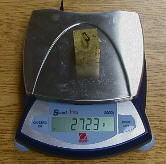 Set up the balance. Turn it on and zero it.
Determine the weight of the metal block.
Set up the balance. Turn it on and zero it.
Determine the weight of the metal block.Note: The readout of the balance is in kg, the weight is m*g.
In this laboratory you will first investigate properties of fluid pressure. You will then determine the density of a metal block by applying Archimedes' principle.
Open a Microsoft Word document to keep a log of your experimental procedures, results and discussions. This log will form the basis of your lab report. Address the points highlighted in blue. Answer all questions.
Exploration
Open the simulation Under Pressure.
The interface
Explore how the pressure in the liquid changes as a function of depth, liquid density, filling level, and external conditions. Answer the questions below, always supporting your answer with data from a measurement.
Experiment
Each group has four metal blocks, a small metal can, a can with a spout, and a container to hold extra water. Each group will determine the density of the metal blocks using a balance only.
Record all your measurements in a table in your log.
| wblock | wempty small can | wsmall can with water | wdisplaced water | wbuoyant | Vwater | ρblock | |
| Block 1 | |||||||
| Block 2 | |||||||
| Block 3 | |||||||
| Block 4 |
For each block:
 Set up the balance. Turn it on and zero it.
Determine the weight of the metal block.
Set up the balance. Turn it on and zero it.
Determine the weight of the metal block.
Note: The readout of the balance is in kg, the weight is m*g.
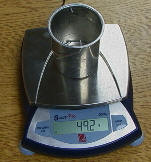 Determine the weight of the small metal can.
Determine the weight of the small metal can.
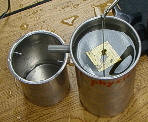 Fill the can with the spout with water until it overflows. Catch the overflow in the small can and discard it.
Fill the can with the spout with water until it overflows. Catch the overflow in the small can and discard it.
Then lower the metal block into the water and catch the displaced water with the small can.
Determine the weight of the small metal can with the displaced water in it using the balance.
Calculate the weight of the displaced water by subtracting the weight of the can.
Now we will calculate the buoyant force and compare it to the weight of the
displaced water.
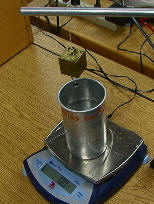 To
make a measurement of the buoyant force, place the can with the spout onto the balance.
To
make a measurement of the buoyant force, place the can with the spout onto the balance.
Make sure there is enough water in it so you can submerge the metal block, but not enough to cause it to overflow onto the balance when you do submerge it.
Zero the balance with the can on it.
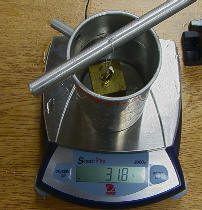 Gently lower the block into the water. Make sure
it is totally submerged but is not touching the walls or bottom of the
can. The water is pushing up on the block with a force equal to wbuoyant.
The scale now measures the reaction force with which the block is pushing
down, which is equal in magnitude to the buoyant force by Newton's third law. Record wbuoyant.
Gently lower the block into the water. Make sure
it is totally submerged but is not touching the walls or bottom of the
can. The water is pushing up on the block with a force equal to wbuoyant.
The scale now measures the reaction force with which the block is pushing
down, which is equal in magnitude to the buoyant force by Newton's third law. Record wbuoyant.
Given the mass of the displaced water calculate its volume.
The density of water is ρ = m/V = 1000 kg/m3, so V = m/(1000 kg/m3).
The volume of the metal block is equal to the volume of the displaced water.
Calculate the density ρblock = mblock/Vwater.
Can you identify the materials your blocks are made of using your result and the table below and the appearance of the blocks?
| Material | Density (kg/m3) |
| Aluminum | 2.7*103 |
| Brass | 8.32*103 |
| Lead | 11.3*103 |
| Copper | 8.96*103 |
| Steel | 7.65*103 |
| Water | 1.0*103 |
Results:
In the next module we will study Bernoulli's equation. Bernoulli's
equations describes the behavior of static fluids and ideal fluids in motion.
For static fluids it tells us how the pressure in a fluid column depends on the
position above the bottom where the pressure is measured.
P1 + ρgh1
= P2 + ρgh2.
For fluids in motion it it gives us a relationship between fluid pressure,
speed, and vertical position. If, for example, a liquid (or a gas which is not being compressed)
is flowing frictionless in a steady state through a horizontal
pipe with a varying cross-sectional area, then the pressure depends on the speed
of the fluid.
The faster the fluid is flowing, the lower is the pressure at the same height.
This may seem counterintuitive to you, but it is a consequence of conservation of energy. The molecules of a fluid at room temperature are always in motion, even if the fluid as a whole is at rest. This disordered motion is responsible for the pressure exerted by the fluid, even in gravity-free space. In a pipe, it results in collisions with the walls. If a fluid is flowing trough a horizontal pipe at a steady rate, then the molecules also have ordered motion. In a narrow section of the pipe the fluid is flowing faster, and more of its energy goes into the ordered motion. This leaves less energy for the random motion and therefore results in softer collisions and lower pressure.
Exercise
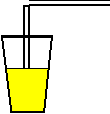
Record your observations and explanations in your log.
Convert your log into a lab report.
Name:
E-mail address:
Laboratory 7 Report
Save your Word document (your name_lab7.docx), go to Canvas, Assignments, Lab 7, and submit your document.